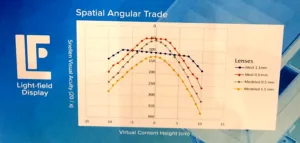FOVi3D was in the i-Zone showing their latest version of the integral imaging type light field display. There were two versions on display – one optimized for spatial resolution and one for angular resolution.
Optimizing for angular resolution increases the FOV and the depth volume, but sacrifices resolution. The image appeared to be about 3-4 inches tall. This display is based on their DevKit2 Lucas version and specs include:
- 9 x 9 x 9cm active light field volume
- 90-degree FOV
- 1mm hogel diameter
- 90×90 hogel display
- 110×110 views per hogel
When optimized for spatial resolution the field of view (FOV) is reduced as is the depth volume. In this case, the image was perhaps 5-6 inches tall. This is the DevKit 2 Wilcox edition. Specs include:
- 9 x 9 x 9cm active light field volume
- 60-degree FOV
- 0.5mm hogel diameter
- 180×180 hogel display
- 50×50 views per hogel
The main difference between these two devices is the size of the lenses in the microlens array, which sets the hogel diameter. The smaller the lens, the fewer the views that can be offered (fewer pixels under the lens). But the more narrow FOV means increased crispness, clarity or resolution (metrology is not well developed to objectively describe image quality yet).
The chart below shows the tradeoff between Snellen visual acuity (essentially, crispness, clarity or resolution) and virtual content height. This suggests that with a specific viewing volume, the 0.5mm hogel will have higher resolution (Snellen acuity), which it does appear to have. Alternatively, this shows that for a constant Snellen acuity, a 1.1mm plenoptic lens pitch create a smaller depth volume than a 0.5mm lens pitch.
This tradeoff is an important parameter when considering the use case of the display – i.e. single or multi-person. A photo of the Wilcox device is shown, but it does not capture the image very well.

As can be seen, these are monochrome green images. The device features an array of OLED-based microdisplays (4.7 micron pixel pitch or 5000ppi), each with a fiber taper and a 2D microlens array on top. Color versions are coming, but these microdisplays use a RGGB filtering arrangement, so resolution will decrease by a factor of 4.
Image quality is in the range as the chart above suggests. The best images at the image plane are still only in the 20:60 acuity range and decrease from there. – CC

